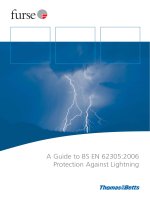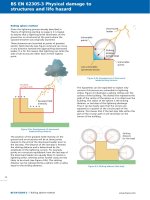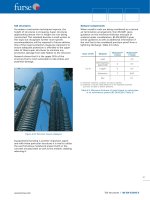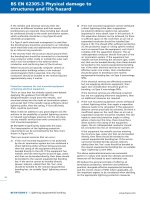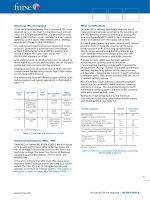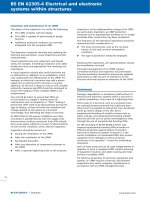Bsi bs en 10149 1 2013
Bạn đang xem bản rút gọn của tài liệu. Xem và tải ngay bản đầy đủ của tài liệu tại đây (1 MB, 20 trang )
BS EN 10149-1:2013
BSI Standards Publication
Hot rolled flat products made
of high yield strength steels for
cold forming
Part 1: General technical delivery conditions
BS EN 10149-1:2013
BRITISH STANDARD
National foreword
This British Standard is the UK implementation of EN 10149-1:2013.
It supersedes BS EN 10149-1:1996 which is withdrawn.
The UK participation in its preparation was entrusted to Technical
Committee ISE/103, Structural Steels Other Than Reinforcements.
A list of organizations represented on this committee can be
obtained on request to its secretary.
This publication does not purport to include all the necessary
provisions of a contract. Users are responsible for its correct
application.
© The British Standards Institution 2013. Published by BSI Standards
Limited 2013
ISBN 978 0 580 73971 2
ICS 77.140.50
Compliance with a British Standard cannot confer immunity from
legal obligations.
This British Standard was published under the authority of the
Standards Policy and Strategy Committee on 30 September 2013.
Amendments issued since publication
Date
Text affected
BS EN 10149-1:2013
EN 10149-1
EUROPEAN STANDARD
NORME EUROPÉENNE
EUROPÄISCHE NORM
September 2013
ICS 77.140.50
Supersedes EN 10149-1:1995
English Version
Hot rolled flat products made of high yield strength steels for
cold forming - Part 1: General technical delivery conditions
Produits plats laminés à chaud en aciers à haute limite
d'élasticité pour formage à froid - Partie 1: Conditions
générales techniques de livraison
Warmgewalzte Flacherzeugnisse aus Stählen mit hoher
Streckgrenze zum Kaltumformen - Teil 1: Allgemeine
technische Lieferbedingungen
This European Standard was approved by CEN on 17 August 2013.
CEN members are bound to comply with the CEN/CENELEC Internal Regulations which stipulate the conditions for giving this European
Standard the status of a national standard without any alteration. Up-to-date lists and bibliographical references concerning such national
standards may be obtained on application to the CEN-CENELEC Management Centre or to any CEN member.
This European Standard exists in three official versions (English, French, German). A version in any other language made by translation
under the responsibility of a CEN member into its own language and notified to the CEN-CENELEC Management Centre has the same
status as the official versions.
CEN members are the national standards bodies of Austria, Belgium, Bulgaria, Croatia, Cyprus, Czech Republic, Denmark, Estonia,
Finland, Former Yugoslav Republic of Macedonia, France, Germany, Greece, Hungary, Iceland, Ireland, Italy, Latvia, Lithuania,
Luxembourg, Malta, Netherlands, Norway, Poland, Portugal, Romania, Slovakia, Slovenia, Spain, Sweden, Switzerland, Turkey and United
Kingdom.
EUROPEAN COMMITTEE FOR STANDARDIZATION
COMITÉ EUROPÉEN DE NORMALISATION
EUROPÄISCHES KOMITEE FÜR NORMUNG
CEN-CENELEC Management Centre: Avenue Marnix 17, B-1000 Brussels
© 2013 CEN
All rights of exploitation in any form and by any means reserved
worldwide for CEN national Members.
Ref. No. EN 10149-1:2013: E
BS EN 10149-1:2013
EN 10149-1:2013 (E)
Contents
Page
Foreword .......................................................................................................................................................3
1
Scope ................................................................................................................................................4
2
Normative references .......................................................................................................................4
3
Terms and definitions ......................................................................................................................5
4
4.1
4.2
Information to be supplied by the purchaser .................................................................................. 6
Mandatory information.....................................................................................................................6
Options .............................................................................................................................................6
5
5.1
5.2
Dimensions, mass and tolerances .................................................................................................. 6
Dimensions and tolerances .............................................................................................................6
Mass of steel ....................................................................................................................................6
6
6.1
6.2
Classification and designation ........................................................................................................ 6
Classification and grades ................................................................................................................6
Designation ......................................................................................................................................6
7
7.1
7.2
7.3
7.4
7.5
7.6
7.7
Technical requirements ...................................................................................................................7
Steel manufacturing process........................................................................................................... 7
Delivery condition ............................................................................................................................7
Chemical composition .....................................................................................................................8
Mechanical properties......................................................................................................................9
Technological properties .................................................................................................................9
Surface finish ................................................................................................................................. 10
Internal soundness ........................................................................................................................ 10
8
8.1
8.2
8.3
8.4
8.5
8.6
8.7
8.8
Inspection and testing ................................................................................................................... 11
General ........................................................................................................................................... 11
Sampling......................................................................................................................................... 11
Test units ........................................................................................................................................ 11
Verification of chemical composition............................................................................................ 11
Preparation of samples and test pieces ........................................................................................ 11
Test methods.................................................................................................................................. 12
Retests and resubmission for testing ........................................................................................... 13
Inspection documents ................................................................................................................... 13
9
Marking ........................................................................................................................................... 14
10
Disputes.......................................................................................................................................... 14
11
Options ........................................................................................................................................... 14
Bibliography................................................................................................................................................ 16
2
BS EN 10149-1:2013
EN 10149-1:2013 (E)
Foreword
This document (EN 10149-1:2013) has been prepared by Technical Committee ECISS/TC 103 “Structural
steel other than reinforcements”, the secretariat of which is held by DIN.
This European Standard shall be given the status of a national standard, either by publication of an identical
text or by endorsement, at the latest by March 2014, and conflicting national standards shall be withdrawn at
the latest by March 2014.
Attention is drawn to the possibility that some of the elements of this document may be the subject of patent
rights. CEN [and/or CENELEC] shall not be held responsible for identifying any or all such patent rights.
This document supersedes EN 10149-1:1995.
In comparison with EN 10149-1:1995, the following significant technical changes were made:
definition 3.2, Note 1 modified;
subclause 7.4.1.1, Note modified and changed to standard text;
subclause 7.5.1, Note 2 for welding suitability of grades S900MC and S960MC added;
Table 1, values for Mn, Ti and Mo modified.
The specific requirements for hot rolled products made of high yield strength steels for cold forming are given
in the EN 10149-2 and EN 10149-3. The titles of the other Parts of this European Standard are:
Part 2: Technical delivery conditions for thermomechanical rolled steels;
Part 3: Technical delivery conditions for normalized or normalized rolled steels.
According to the CEN-CENELEC Internal Regulations, the national standards organisations of the following
countries are bound to implement this European Standard: Austria, Belgium, Bulgaria, Croatia, Cyprus, Czech
Republic, Denmark, Estonia, Finland, Former Yugoslav Republic of Macedonia, France, Germany, Greece,
Hungary, Iceland, Ireland, Italy, Latvia, Lithuania, Luxembourg, Malta, Netherlands, Norway, Poland, Portugal,
Romania, Slovakia, Slovenia, Spain, Sweden, Switzerland, Turkey and the United Kingdom.
3
BS EN 10149-1:2013
EN 10149-1:2013 (E)
1
Scope
1.1 This European Standard specifies requirements for flat products made of weldable, hot-rolled, high yield
strength alloy quality and special steels for cold forming.
EN 10149-1 specifies the general delivery conditions.
EN 10149-2 specifies the delivery conditions for thermomechanically rolled steels in the grades given in
Table 1 (chemical composition) and Table 2 (mechanical properties) of Part 2.
EN 10149-3 specifies the delivery conditions for normalised or normalised rolled steels in the grades given in
Table 1 (chemical composition) and Table 2 (mechanical properties) of Part 3.
1.2 This European Standard does not apply to products for pressure vessels and products for which other
European Standards exist or European Standards dealing with steels for general structural applications are
being prepared:
Hot-rolled products of structural steels (see EN 10025 parts 1 to 6);
Hot finished structural hollow sections of non-alloy and fine grain steels (see EN 10210-1).
2
Normative references
The following documents, in whole or in part, are normatively referenced in this document and are
indispensable for its application. For dated references, only the edition cited applies. For undated references,
the latest edition of the referenced document (including any amendments) applies.
EN 10020, Definition and classification of grades of steel
EN 10021, General technical delivery conditions for steel products
EN 10029, Hot-rolled steel plates 3 mm thick or above - Tolerances on dimensions and shape
EN 10048, Hot-rolled narrow steel strip – Tolerances on dimensions and shape
EN 10051, Continuously hot-rolled strip and plate/sheet cut from wide strip of non-alloy and alloy steels –
Tolerances on dimensions and shape
EN 10052:1993, Vocabulary of heat treatment terms for ferrous products
EN 10079:2007, Definition of steel products
EN 10149-2:2013, Hot rolled flat products made of high yield strength steels for cold forming – Part 2:
Technical delivery conditions for thermomechanically rolled steels
EN 10149-3:2013, Hot rolled flat products made of high yield strength steels for cold forming – Part 3:
Technical delivery conditions for normalized or normalized rolled steels
EN 10160, Ultrasonic testing of steel flat product of thickness equal to or greater than 6 mm (reflection
method)
EN 10162, Cold-rolled steel sections – Technical delivery conditions – Dimensional and cross-sectional
tolerances
4
BS EN 10149-1:2013
EN 10149-1:2013 (E)
EN 10163-1, Delivery requirements for surface condition of hot-rolled steel plates, wide flats and sections –
Part 1: General requirements
EN 10163-2, Delivery requirements for surface condition of hot-rolled steel plates, wide flats and sections –
Part 2: Plate and wide flats
EN 10168, Steel products – Inspection documents – List of information and description
EN 10204, Metallic products – Types of inspection documents
EN ISO 148-1, Metallic materials – Charpy pendulum impact test – Part 1: Test method (ISO 148-1)
EN ISO 377, Steel and steel products – Location and preparation of samples and test pieces for mechanical
testing (ISO 377)
EN ISO 2566-1, Steel – Conversion of elongation values – Part 1: Carbon and low alloy steels (ISO 2566-1)
EN ISO 6892-1:2009, Metallic materials – Tensile testing – Part 1: Method of test at room temperature
(ISO 6892-1:2009)
EN ISO 7438, Metallic materials – Bend test (ISO 7438)
3
Terms and definitions
For the purposes of this document, the terms and definitions given in EN 10052:1993, EN 10079:2007 and the
following apply.
3.1
fine grained steels
steels with fine grain structure with an equivalent index of ferritic grain size ≥ 6
Note 1 to entry:
For the determination of grain sizes, see EN ISO 643.
3.2
thermomechanical rolling
rolling process in which the final deformation is carried out in a certain temperature range leading to a material
condition with certain properties which cannot be achieved or repeated by heat treatment alone
Note 1 to entry:
Hot forming or post weld heat treatment at a temperature above 580 °C may lower the strength values
and for this reason is better not performed. Flame straightening can be applied in accordance with CEN/TR 10347. For
grades S900MC and S960MC, subsequent heating at temperature above 400 °C is not recommended.
Note 2 to entry:
Thermomechanical rolling can include processes with an increasing cooling rate with or without
tempering including self-tempering but excluding direct quenching and quenching and tempering.
Note 3 to entry:
In some publications, the word TMCP (Thermomechanical Control Process) is also used.
3.3
normalised rolled
rolling process in which the final deformation is carried out in a certain temperature range leading to a material
condition equivalent to that obtained after normalising so that the specified values of the mechanical
properties are retained even after normalising
Note 1 to entry:
In international publications for both the normalising rolling, as well as the thermomechanical rolling,
the expression "controlled rolling" may be found. However, in view of the different applicability of the products, a distinction
of the terms is necessary.
5
BS EN 10149-1:2013
EN 10149-1:2013 (E)
4
Information to be supplied by the purchaser
4.1
Mandatory information
The following information shall be supplied by the purchaser at the time of the order:
a)
details of the product form and quantity;
b)
reference to this European Standard;
c)
nominal dimensions and tolerances (see 5.1);
d)
the grade and delivery condition of the steel (see EN 10149-2 and EN 10149-3);
e)
type of inspection document (see 8.8).
4.2
Options
A number of options are specified in Clause 11. In the event that the purchaser does not indicate his wish to
implement any of these options, the supplier shall supply in accordance with the basic specification.
5
Dimensions, mass and tolerances
5.1
Dimensions and tolerances
Dimensions and tolerances shall be in accordance with EN 10029, EN 10048 or EN 10051.
5.2
Mass of steel
The calculated mass shall be determined using a volumetric mass of 7,85 kg/dm3.
6
Classification and designation
6.1
Classification and grades
Classification shall be in accordance with EN 10149-2 and EN 10149-3 which specify steel grades that are
alloy quality steels or alloy special steels according to EN 10020.
The steels for flat products specified in EN 10149-2 and EN 10149-3 are subdivided into grades on the basis
of the minimum specified yield strength at ambient temperature.
6.2
6.2.1
Designation
Steel names and steel numbers
For the steel grades covered by this European Standard, the steel names are allocated in accordance with
EN 10027-1; the steel numbers are allocated in accordance with EN 10027-2.
6
BS EN 10149-1:2013
EN 10149-1:2013 (E)
6.2.2
Details for the designation
The designation shall consist of:
the number of this European Standard (EN 10149-2 or EN 10149-3);
the steel number or the steel name consisting of:
the symbol S (for structural steel);
the indication of the minimum specified yield strength expressed in MPa 1);
the symbol for the delivery condition (M or N) (see EN 10149-2 and EN 10149-3);
the capital letter C indicating the steel is suitable for cold forming (see EN 10149-2 and EN 10149-3).
EXAMPLE 1
Thermomechanically rolled (M) structural steels (S) with a specified minimum yield strength at room
temperature of 420 MPa1) (420) suitable for cold forming (C):
Steel EN 10149-2 - 1.0980
or
Steel EN 10149-2 - S420MC
EXAMPLE 2
Structural steels (S) with a specified minimum yield strength at room temperature of 420 MPa1) (420) in
the normalised or normalised rolled condition (N) suitable for cold forming (C):
Steel EN 10149-3 - 1.0981
or
Steel EN 10149-3 - S420NC
7
Technical requirements
7.1
Steel manufacturing process
7.1.1 The steel manufacturing process shall be at the manufacturer's option. If specified at the time of the
order, the steel manufacturing process shall be reported to the purchaser.
See Clause 11, option 1).
7.1.2 The steels specified in this European Standard shall be fully killed. The steels shall have a fine grain
structure containing nitrogen binding elements in amounts sufficient to bind the available nitrogen.
7.2
7.2.1
Delivery condition
Thermomechanically rolled steel
The products described in EN 10149-2 are obtained by thermomechanical rolling.
1) 1 MPa = 1 N/mm2.
7
BS EN 10149-1:2013
EN 10149-1:2013 (E)
7.2.2
Normalised or normalised rolled steel
The products described in EN 10149-3 are delivered in the normalised or normalised rolled condition.
7.2.3
Surface protection
Unless otherwise agreed at the time of the order, the products are generally supplied with their surfaces in
untreated condition. If agreed at the time of the order, the products may be delivered with descaled surfaces.
However, it is necessary to take into account the fact that certain descaling processes are liable to modify the
cold forming properties.
See Clause 11, option 2).
The descaled continuous rolled products are normally supplied oiled. In this case, their two faces shall be
coated with a uniform layer of neutral, non-siccative oil, free from foreign matters, so that under dry conditions
of packaging, transportation, handling and storing, the products can be protected from corrosion for at least
three months.
When descaled products are supplied oiled, the oil coating shall be removable using alkaline solutions or any
other usual solvent.
The type of oil shall be left to the discretion of the manufacturer, unless otherwise agreed.
If transportation or storage conditions are such that special corrosion protection is required, the purchaser
shall inform the manufacturer at the time of the order.
If the purchaser does not require surface oiling, he shall clearly state so at the time of the order. In addition,
the purchaser should be made aware of the higher risk of scratches during handling, transportation and
application.
NOTE
7.3
When products are ordered in the un-oiled condition, there is no manufacturer's liability for rust hazards.
Chemical composition
7.3.1 The chemical composition determined by ladle analysis shall comply with the values in EN 10149-2
and EN 10149-3.
7.3.2 The values for the chemical composition as specified in EN 10149-2 and EN 10149-3 are the
permitted limits or ranges, between which the various steel grades are delivered.
If agreed at the time of the order, the manufacturer shall inform the purchaser which of the alloying elements
appropriate to the steel grade required will be deliberately added to the material to be delivered.
See Clause 11, option 3).
7.3.3 As the form of sulphide inclusions has an influence on the cold formability of the products, the
manufacturer may at his option influence the form of inclusions by adding certain elements (e.g. Ce, Ca) or
select a very low sulphur content.
7.3.4
The product analysis shall be carried out when specified at the time of the order.
See Clause 11, option 4).
The permissible deviations of the product analysis from the specified limits of the ladle analysis shall be as
given in Table 1.
8
BS EN 10149-1:2013
EN 10149-1:2013 (E)
7.4
Mechanical properties
7.4.1
General
7.4.1.1
Under the inspection and testing conditions as specified in Clause 8 and in the delivery condition
as specified in 7.2, the mechanical properties shall comply with the relevant requirements of EN 10149-2 and
EN 10149-3.
Stress relieving at more than 580 °C or for over 1 h may lead to a deterioration of the mechanical properties.
For normalised or normalised rolled steel grades, the maximum stress relief temperature should be 560 °C. If
the purchaser intends to stress relief the products at higher temperatures or for longer times than mentioned
above, the minimum values of the mechanical properties after such a treatment should be agreed at the time
of the order.
For grades S900MC and S960MC, subsequent heating at temperatures above 400 °C is not recommended. If
the purchaser intends to stress relief the products at higher temperatures, the minimum values of the
mechanical properties after such a treatment should be agreed at the time of the order.
7.4.1.2
For the products specified in EN 10149-2 and EN 10149-3, the nominal thickness shall apply.
7.4.1.3
For products ordered and supplied in the normalised or normalised rolled condition, the
mechanical properties shall comply with the relevant tables for mechanical properties of EN 10149-3 in the
normalised or normalised rolled condition or after normalising by heat treatment after delivery or after hot
forming if the provisions of CEN/TR 10347 are satisfied.
7.4.2
Impact energy
7.4.2.1
If agreed at the time of the order, the impact energy shall be verified for products with nominal
thickness ≥ 6 mm.
See Clause 11, option 5).
7.4.2.2
If the nominal product thickness is not sufficient for the preparation of full size impact test pieces,
test pieces of smaller width shall be taken (see 8.5.2.3) and the applicable values shall be decreased
proportionally.
7.5
Technological properties
7.5.1
Weldability
The steels specified in this European Standard shall be suitable for welding processes in current use.
NOTE 1
With increasing product thickness and increasing strength level, cold cracking can occur. Cold cracking is
caused by the following factors in combination:
the amount of diffusible hydrogen in the weld metal;
a brittle structure of the heat affected zone;
significant tensile stress concentrations in the welded joint.
When using recommendations as laid down, for example in EN 1011-2 or any relevant national standard, the
recommended welding conditions and the various welding ranges of the steel grades can be determined
depending on the product thickness, the applied welding energy, the design requirements, the welding
process and the weld metal properties.
NOTE 2
Grades S900MC and S960MC do not have unlimited suitability for the various welding processes, since the
behaviour of these steels during and after welding depend not only on the materials but also on the dimensions and shape
and on the manufacturing and service of the components.
9
BS EN 10149-1:2013
EN 10149-1:2013 (E)
7.5.2
Formability
7.5.2.1
General
NOTE
Recommendations regarding hot and cold forming are laid down in CEN/TR 10347.
7.5.2.2
Cold forming
7.5.2.2.1
Flangeability
The products are suitable for flanging without cracking as given in EN 10149-2 and EN 10149-3.
7.5.2.2.2
Roll forming
If specified at the time of the order plate and strip shall be suitable for the production of sections through coldrolling for example according to EN 10162.
See Clause 11, option 6).
NOTE
The products suitable for roll forming are also suitable for the manufacture of cold-finished square and
rectangular hollow sections.
7.5.3
Hot-dip zinc-coating
Grades S315MC to S700MC of EN 10149-2 and all grades of EN 10149-3 can be ordered with requirements
on the chemical composition of steel in respect to hot-dip zinc-coating according to EN 10149-2 and
EN 10149-3.
See Clause 11, option 7).
7.6
7.6.1
Surface finish
Strip
The surface condition shall not impair an application appropriate to the steel grade if adequate processing of
the strip is applied.
7.6.2
Plates and wide flats
EN 10163-1 and EN 10163-2 apply for the permissible surface discontinuities and for the repair of surface
defects by grinding and/or welding.
Unless otherwise agreed previously with the purchaser, repair by welding is not allowed.
See Clause 11, option 8).
7.7
Internal soundness
The products shall be free from internal defects which would exclude them from being used for the usual
purpose.
Ultrasonic testing may be agreed at the time of the order (see 8.6.3).
See Clause 11, option 9).
10
BS EN 10149-1:2013
EN 10149-1:2013 (E)
8
Inspection and testing
8.1
General
8.1.1 The products shall be supplied with specific inspection and testing with respect to their compliance
with this European Standard.
8.1.2
8.8).
The purchaser shall specify the type of the inspection document at the time of the order (see 4.1 and
8.1.3
The specific inspection and testing shall be carried out in accordance with 8.2 to 8.7.
8.1.4 Unless otherwise agreed at the time of the order, inspection of surface condition and dimensions shall
be carried out by the manufacturer.
See Clause 11, option 10).
8.2
Sampling
The verification of the mechanical properties shall be by cast.
8.3
Test units
For verifying the mechanical properties, the following test unit shall apply:
- 40 t or part thereof.
The test unit shall contain products of the same grade, form and thickness.
8.4
Verification of chemical composition
8.4.1
For ladle analysis determined for each cast, the values reported by the manufacturer shall apply.
8.4.2 Product analysis shall be carried out if agreed at the time of the order. The purchaser shall specify the
number of samples and the elements to be determined.
See Clause 11, option 4).
8.5
Preparation of samples and test pieces
8.5.1
Preparation of samples
8.5.1.1
The samples shall be taken as given in EN 10149-2 or EN 10149-3.
8.5.1.2
The sample product can be any product within the test unit.
8.5.1.3
For plates, sheet, wide strip and wide flats, the samples shall be taken approximately midway
between the edge and centre line of the products.
For wide strip, the sample shall be taken at an adequate distance from the end of the coil.
For narrow strip (< 600 mm wide), the sample shall be at an adequate distance from the end and at one third
of the width.
11
BS EN 10149-1:2013
EN 10149-1:2013 (E)
8.5.2
Preparation of test pieces
8.5.2.1
General
In addition to the requirements EN ISO 377, EN 10149-2:2013, Annex A, and EN 10149-3:2013, Annex A,
shall apply.
8.5.2.2
Tensile test pieces
The requirements of EN ISO 6892-1 shall apply.
Test pieces may be non-proportional but in cases of dispute proportional test pieces having a gauge length
Lo = 5,65,
So
shall be used (see 8.6.2.1).
For flat products with a nominal thickness < 3 mm, the test pieces shall always have a gauge length
Lo = 80 mm and a width of 20 mm (test piece number 2 EN ISO 6892-1:2009, Annex B).
Both rolled surfaces shall remain on the tensile test pieces.
8.5.2.3
Impact test pieces
V-notch test pieces shall be machined and prepared in accordance with EN ISO 148-1. In addition, the
following shall apply:
a)
for nominal thickness > 12 mm, standard 10 mm x 10 mm test pieces shall be machined in such a way
that one side is not further away than 2 mm from a rolled surface;
b)
for nominal thickness ≤ 12 mm, when test pieces with reduced widths are used, the minimum width shall
be ≥ 5 mm (see 7.4.2.2).
8.5.2.4
Chemical analysis samples
The preparation of samples for product analysis shall be in accordance with EN ISO 377.
8.6
Test methods
8.6.1
Chemical analysis
For the determination of the chemical composition, the corresponding European Standards shall apply in
cases of dispute.
8.6.2
Mechanical test
Mechanical tests shall be carried out in the temperature range 10 °C to 35 °C, except where a specific
temperature is specified for impact tests (see 7.4.2.1).
8.6.2.1
Tensile test
The tensile test shall be carried out in accordance with EN ISO 6892-1. The manufacturer may choose
between method A or B.
For the specified yield strength in Table 2 of EN 10149-2 and EN 10149-3, the upper yield strength (ReH) shall
be determined.
If a yield phenomenon is not present the 0,2 % proof strength (Rp0,2) shall be determined.
12
BS EN 10149-1:2013
EN 10149-1:2013 (E)
If a non-proportional test piece is used for products with a thickness ≥ 3 mm, the percentage elongation value
obtained shall be converted to the value for a gauge length Lo = 5,65
EN ISO 2566-1.
8.6.2.2
So
using the conversion tables given in
Impact test
If specified at the time of order (see 7.4.2.1), the impact test shall be carried out in accordance with
EN ISO 148-1 using the 2 mm striker.
The average value of the three test results shall meet the specified requirement. One individual value may be
below the minimum average value specified, provided that it is not less than 70 % of that value.
Three additional test pieces shall be taken from the same sample in accordance with 8.5.1 and tested in any
one of the following cases:
if the average of three impact values is lower than the minimum average value specified;
if the average value meets the specified requirement, but two individual values are lower than the
minimum average value specified;
if any one value is lower than 70 % of the minimum average value specified.
The average value of the six tests shall be not less than the minimum average value specified. Not more than
two of the individual values may be lower than the minimum average value specified and not more than one
may be lower than 70 % of this value.
8.6.2.3
Bend test
The bend test shall be carried out in accordance with EN ISO 7438. Both rolled surfaces shall remain on the
test piece.
8.6.3
Ultrasonic testing
If specified at the time of the order (see 7.7), ultrasonic testing shall be carried out for plate with nominal
thickness ≥ 6 mm in accordance with EN 10160.
See Clause 11, option 9).
8.7
Retests and resubmission for testing
EN 10021 shall apply in respect of all retests and resubmission for testing.
In the case of strip, retests on a rejected coil shall be carried out after the cutting of an additional longitudinal
section of sufficient length to remove the coil end effect with a maximum of 20 m.
8.8
Inspection documents
One of the inspection documents mentioned in EN 10204 for specific testing shall be supplied.
In these documents, the information groups A, B and Z and the code numbers C00-C03, C10-C13, C40-C43
and C70-C92 according to EN 10168 shall be included. Code number Z02 applies only for inspection
certificates type 3.2 (see 4.1.e).
13
BS EN 10149-1:2013
EN 10149-1:2013 (E)
9
Marking
9.1 The products shall be marked by a suitable durable method such as painting, stamping, durable
adhesive labels or attached tags with the following:
the grade and delivery condition indicated by its designation (e.g. S420MC or 1.0980);
a number by which the cast and the sample can be identified;
the manufacturer's name or trademark;
the mark of the external inspection body (where applicable).
9.2 Marking shall be at a position close to one end of each product or on the end cut face at the
manufacturer's discretion.
9.3 If specified at the time of the order, stamping of the steel shall either be avoided or confined to positions
indicated by the purchaser.
See Clause 11, option 11).
9.4 If light products are to be supplied in securely tied bundles, the marking shall be on a label attached to
the bundle or on the top product of the bundle.
10 Disputes
EN 10021 shall apply in respect of disputes.
11 Options
See 4.2.
1) The steel manufacturing process shall be indicated (see 7.1.1).
2) The products shall be delivered with descaled surfaces (see 7.2.3).
3) The manufacturer shall inform the purchaser at the time of the order which of the alloying elements
appropriate to the steel grade required will be deliberately added to the material to be delivered (see 7.3.2).
4) Product analysis shall be carried out and if so the number of samples and the elements to be determined
(see 7.3.4 and 8.4.2).
5) The impact test shall be carried out with longitudinal test pieces (see 7.4.2.1):
a) at -20 °C and the minimum impact energy value will be 40 J;
b) at -40 °C and the minimum impact energy value will be 27 J.
6) Products shall be suitable for roll forming (see 7.5.2.2.2).
7) Grades S315MC to S700MC of EN 10149-2 and all grades of EN 10149-3 shall have a chemical
composition required for hot-dip zinc coating (see 7.5.3).
8) Repair by welding is allowed (see 7.6.2).
14
BS EN 10149-1:2013
EN 10149-1:2013 (E)
9) Internal defects shall be tested in accordance with EN 10160 for plate with nominal thickness ≥ 6 mm (see
7.7 and 8.6.3).
10) Inspection of surface condition and dimensions shall be carried out by the purchaser or his authorised
representative at the manufacturer's works (see 8.1.4).
11) Stamping of steel is either not allowed or allowed in the position indicated by the purchaser (see 9.3).
Table 1 — Permissible deviations of the product analysis from the specified limits of the ladle analysis
Element
Specified limit in the
ladle analysis
% by mass
Permissible deviation of the
product analysis from specified
limits for the ladle analysis
% by mass
C
≤ 0,20
+ 0,02
Mn
≤ 2,20
+ 0,10
Si
≤ 0,60
+ 0,05
P
≤ 0,025
+ 0,005
S
≤ 0,020
+ 0,002
Altotal
≥ 0,015
- 0,005
Nb
≤ 0,09
+ 0,01
V
≤ 0,20
+ 0,02
Ti
≤ 0,25
+ 0,01
Mo
≤ 1,00
+ 0,05
B
≤ 0,005
+ 0,001
15
BS EN 10149-1:2013
EN 10149-1:2013 (E)
Bibliography
[1]
EN 1011-2, Welding - Recommendations for welding of metallic materials - Part 2: Arc welding of
ferritic steels
[2]
EN 10025-1, Hot rolled products of structural steels - Part 1: General technical delivery conditions
[3]
EN 10025-2 Hot rolled products of structural steels - Part 2: Technical delivery conditions for non-alloy
structural steels
[4]
EN 10025-3, Hot rolled products of structural steels - Part 3: Technical delivery conditions for
normalized/normalized rolled weldable fine grain structural steels
[5]
EN 10025-4, Hot rolled products of structural steels - Part 4: Technical delivery conditions for
thermomechanical rolled weldable fine grain structural steels
[6]
EN 10025-5, Hot rolled products of structural steels - Part 5: Technical delivery conditions for structural
steels with improved atmospheric corrosion resistance
[7]
EN 10025-6, Hot rolled products of structural steels - Part 6: Technical delivery conditions for flat
products of high yield strength structural steels in the quenched and tempered condition
[8]
EN 10210-1, Hot finished structural hollow sections of non-alloy and fine grain steels - Part 1:
Technical delivery conditions
[9]
EN ISO 643, Steels – Micrographic determination of the apparent grain size (ISO 643)
[10]
CEN/TR 10347, Guidance for forming of structural steels in processing
[11]
EN 10027-1, Designation systems for steels - Part 1: Steel names
[12]
EN 10027-2, Designation systems for steels - Part 2: Numerical system
16
This page deliberately left blank
NO COPYING WITHOUT BSI PERMISSION EXCEPT AS PERMITTED BY COPYRIGHT LAW
British Standards Institution (BSI)
BSI is the national body responsible for preparing British Standards and other
standards-related publications, information and services.
BSI is incorporated by Royal Charter. British Standards and other standardization
products are published by BSI Standards Limited.
About us
Revisions
We bring together business, industry, government, consumers, innovators
and others to shape their combined experience and expertise into standards
-based solutions.
Our British Standards and other publications are updated by amendment or revision.
The knowledge embodied in our standards has been carefully assembled in
a dependable format and refined through our open consultation process.
Organizations of all sizes and across all sectors choose standards to help
them achieve their goals.
Information on standards
We can provide you with the knowledge that your organization needs
to succeed. Find out more about British Standards by visiting our website at
bsigroup.com/standards or contacting our Customer Services team or
Knowledge Centre.
Buying standards
You can buy and download PDF versions of BSI publications, including British
and adopted European and international standards, through our website at
bsigroup.com/shop, where hard copies can also be purchased.
If you need international and foreign standards from other Standards Development
Organizations, hard copies can be ordered from our Customer Services team.
Subscriptions
Our range of subscription services are designed to make using standards
easier for you. For further information on our subscription products go to
bsigroup.com/subscriptions.
With British Standards Online (BSOL) you’ll have instant access to over 55,000
British and adopted European and international standards from your desktop.
It’s available 24/7 and is refreshed daily so you’ll always be up to date.
You can keep in touch with standards developments and receive substantial
discounts on the purchase price of standards, both in single copy and subscription
format, by becoming a BSI Subscribing Member.
PLUS is an updating service exclusive to BSI Subscribing Members. You will
automatically receive the latest hard copy of your standards when they’re
revised or replaced.
To find out more about becoming a BSI Subscribing Member and the benefits
of membership, please visit bsigroup.com/shop.
With a Multi-User Network Licence (MUNL) you are able to host standards
publications on your intranet. Licences can cover as few or as many users as you
wish. With updates supplied as soon as they’re available, you can be sure your
documentation is current. For further information, email
BSI Group Headquarters
389 Chiswick High Road London W4 4AL UK
We continually improve the quality of our products and services to benefit your
business. If you find an inaccuracy or ambiguity within a British Standard or other
BSI publication please inform the Knowledge Centre.
Copyright
All the data, software and documentation set out in all British Standards and
other BSI publications are the property of and copyrighted by BSI, or some person
or entity that owns copyright in the information used (such as the international
standardization bodies) and has formally licensed such information to BSI for
commercial publication and use. Except as permitted under the Copyright, Designs
and Patents Act 1988 no extract may be reproduced, stored in a retrieval system
or transmitted in any form or by any means – electronic, photocopying, recording
or otherwise – without prior written permission from BSI. Details and advice can
be obtained from the Copyright & Licensing Department.
Useful Contacts:
Customer Services
Tel: +44 845 086 9001
Email (orders):
Email (enquiries):
Subscriptions
Tel: +44 845 086 9001
Email:
Knowledge Centre
Tel: +44 20 8996 7004
Email:
Copyright & Licensing
Tel: +44 20 8996 7070
Email:

